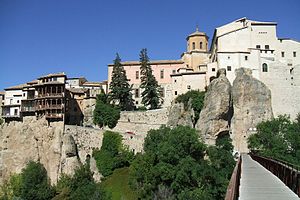Cuenca (Spain)
| Cuenca | |||
|---|---|---|---|

View of Los Canónigos, Casas Colgadas (in the foreground), San Pablo Bridge (bottom left) and Downtown Cuenca (background), as seen from Palomera highway
|
|||
|
|||
| Location of Cuenca within Spain | |||
| Coordinates: 40°4′N 2°9′W / 40.067°N 2.150°WCoordinates: 40°4′N 2°9′W / 40.067°N 2.150°W | |||
| Country | Spain | ||
| Autonomous community | Castile–La Mancha | ||
| Province | Cuenca | ||
| Comarca | Serranía Media | ||
| Government | |||
| • Mayor (2011) | Ángel Mariscal (PP) | ||
| Area | |||
| • Total | 911.06 km2 (351.76 sq mi) | ||
| Elevation | 946 m (3,104 ft) | ||
| Population (2012) | |||
| • Total | 57,032 | ||
| • Density | 63/km2 (160/sq mi) | ||
| Demonym(s) | Conquense | ||
| Time zone | CET (UTC+1) | ||
| • Summer (DST) | CEST (UTC+2) | ||
| Postal code | 16000 | ||
| Website | Official website | ||
| Historic Walled Town of Cuenca | |
|---|---|
| Name as inscribed on the World Heritage List | |
 |
|
| Location | Spain |
| Type | Cultural |
| Criteria | ii, v |
| Reference | 781 |
| UNESCO region | Europe and North America |
| Coordinates | 40°02′N 2°00′E / 40.04°N 2°E |
| Inscription history | |
| Inscription | 1996 (20th Session) |
Cuenca (Spanish pronunciation: [ˈkweŋka]) is a city in the autonomous community of Castile–La Mancha in central Spain. It is the capital of the province of Cuenca.
Cuenca is located across a steep spur, whose slopes descend into deep gorges of the Júcar and Huécar rivers. It is divided into two separate settlements: the "new" city is situated south-west of the old one, which is divided by the Huécar course.
The climate of Cuenca is the typical continental Mediterranean of Spain's "Meseta" (inner plateau). Winters are relatively cold, but summers are quite hot during the day with occasional cool nights. Spring and autumn seasons are short, with pleasant temperatures during the day but with rather cold nights due to its altitude from 956 m above sea level up to 1000 m in the old town.
When the Iberian peninsula was part of the Roman Empire, there were several important settlements in the province, such as Segobriga, Ercavica and Gran Valeria. However, the place where Cuenca is located today was uninhabited at that time.
When the Muslim Arabs captured the area in 714, they soon realized the value of this strategic location and they built a fortress (called Kunka) between two gorges dug between the Júcar and Huécar rivers, surrounded by a 1 km-long wall. Cuenca soon became an agricultural and textile manufacturing city, enjoying growing prosperity.
Around the 12th century the Christians, living in northern Spain during the Muslim presence, started to slowly recover the Iberian peninsula. Castile took over western and central areas of Spain, while Aragon enlarged along the Mediterranean area. The Muslim Kingdom, Al-Andalus, started to break into small provinces (Reinos de taifas) under Christian pressure, Cuenca being part of the taifa of Toledo. In 1076 it was besieged by Sancho Ramírez of Aragon, but not conquered. In 1080 King Yahya al-Qadir of Toledo lost his taifa, and his vizier signed in Cuenca a treaty with Alfonso VI of León and Castile by which he ceded him some fortresses in exchange for military help.
...
Wikipedia



